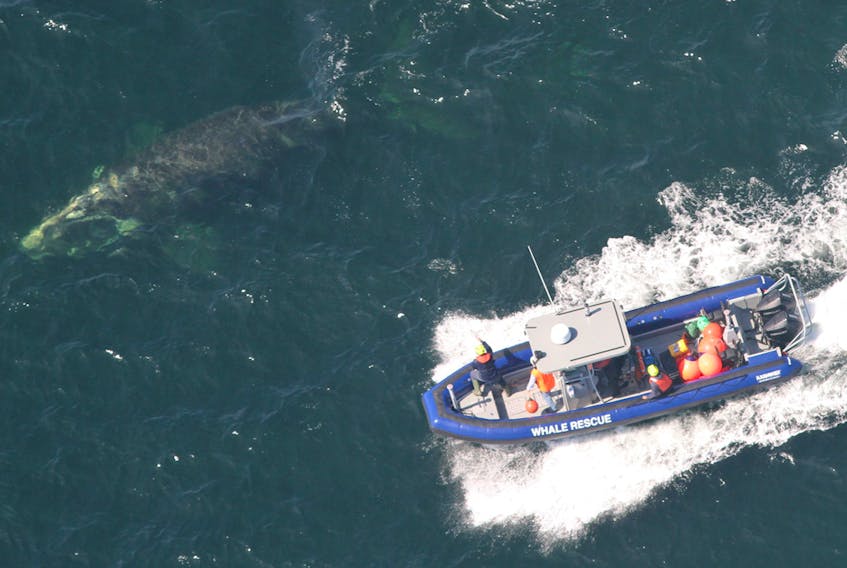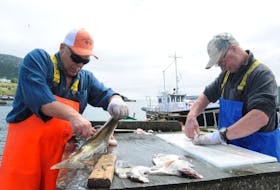It was 5:30 a.m. on Thursday when a small boat nicknamed Scamper left a wharf at Shippagan, N.B., in search of a right whale longer than it. Aboard were five members of the Campobello Whale Rescue Team.
A surveillance flight by a U.S. National Oceanic and Atmospheric Administration (NOAA) aircraft, flying out of Moncton, had spotted Right Whale No. 4423 about 65 kilometres off the coast.
The five-year-old whale was tangled in rope and trailing fishing gear that was preventing it from using its tail when diving.
In the ensuing almost 13-hour rescue effort, Scamper’s crew used poles, buoys and specialized knives to partially disentangle the whale — while it was swimming.
“It’s like going to the dentist for a root canal, but while the dentist is doing it, you’re running down the street,” says Moira Brown, a scientist with the Canadian Whale Institute.
There's waves. You can't see the whale underwater. You've got to approach slowly.
The boat should never be directly above the whale, so in most disentanglement operations, the boat travels alongside the whale and throws a “control line,” Brown said.
The line does not actually control the whale, but it has a buoy that pops out of the water when the whale is about to breach, warning the crew that it is near the surface.
“There’s waves. You can’t see the whale underwater. You’ve got to approach slowly,” Brown said. “We usually try to start at the head and work our way toward the tail.”
The team has poles with knives that they reach out to cut the fishing rope. They also throw cutting grapples attached to their own ropes, and the action of towing the rope through the water helps the grapple cut.
This type of operation is not without danger; in 2017, Joe Howlett, a volunteer with the Campobello Whale Rescue Team, died while disentangling a whale. The new boat is named Scamper because it was Howlett’s nickname for his grandson.
“He’s on all of our minds every day,” Brown said of her late friend.
Scamper was custom-built last winter in Dartmouth, N.S., by a company called Rosborough, with a grant from the Department of Fisheries and Oceans. It has a fibreglass hull and inflatable tubes on the sides. To name the boat, the Canadian Whale Institute created a contest for children on Campobello Island to submit suggestions, one of which came from Howlett’s grandson.
The team managed to partially free Whale No. 4423 on Thursday, removing fishing gear from his tail, but weather prevented them from returning for additional work on Friday.
In addition to receiving air support from the NOAA on Thursday, the rescuers were also assisted by airborne and on-water personnel from the Department of Fisheries and Oceans.
Brown noted the entire mission ultimately involved three boats, two aircraft and seven institutions, including the Canadian and American federal departments and researchers from Halifax and Boston.
The number of right whales remaining in existence is down to approximately 400.
They have been migrating north in recent summers from the Gulf of Maine to the Gulf of St. Lawrence due to warming water temperatures, and in recent weeks, six whales have died in Canadian waters. While necropsies showed that three of the deaths were due to vessel strikes, fishing gear can also cause the whales to drown.
Brown said researchers are trying to find weaker rope for use by fisheries, from which ensnared whales could more easily break free. Transport Canada and Fisheries and Oceans Canada have increased surveillance and expanded slowdown zones for ships, but a federal study shows the measures are not sufficient to prevent the whales from being hurt or killed in the Atlantic.
Two other entangled right whales were recently observed in the Gulf of St. Lawrence, but disentanglement has not yet been possible.
“We are trying to save the species, basically one at a time,” Brown said.
Copyright Postmedia Network Inc., 2019









